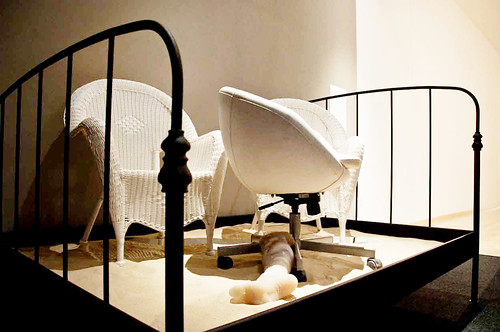Ryan Trecartin, winner of the first Wolgin award, will start new projects with his prize money.

On Oct. 22, Temple’s Tyler School of Art held its award ceremony for the Jack Wolgin International Competition in the Fine Arts. Ryan Trecartin was named the recipient of $150,000, the largest juried visual art prize granted to an individual by a university.
Trecartin said he plans to spend the award money on exactly what he received it for – art.
“I’m literally going to spend all of it on making art,” he said. “The freedom this will give me is going to be taken very seriously, and I’m extremely excited to start a new production with this money.”
The Jack Wolgin competition began when the Philadelphia-based philanthropist decided to donate the $150,000 cash award to an emerging artist who “transcends traditional boundaries.”
“Temple, specifically Tyler, [has] an awards committee,” painting and sculpture professor Philip Glahn said.
The awards committee worked with Jack Wolgin to establish competition guidelines.
“Mr. Wolgin considered [this] to be an international art prize for emerging artists, for young artists. We got together, and the committee decided who would be representative [among artists, curators and critics] internationally to serve as nominators,” Glahn said.
After choosing from the list the committee organized, Glahn explained that they compiled a number of nominators in the United States as well as abroad.
“[We] called them up and said, ‘Who would you like to see? Whose works [deserve] this award and the kind of publicity that comes with it?’ These people then wrote us back, said ‘I would like to nominate this person or that person,’ so we had a pool of artists,” Glahn said.
The committee also chose the jurors who would select the winner. This year’s jurors were Melissa Chiu, museum director and vice president of Global Arts Programs, Asia Society in New York; Paolo Colombo, an art advisor to the Istanbul Museum of Modern Art and director of Dorje Film in Rome; and Ingrid Schaffner, senior curator for the Institute for Contemporary Art in Philadelphia.
Jurors selected finalists New York-based Sanford Biggers, Chicago-based Michael Rakowitzand and Philadelphia-based Ryan Trecartin. They completed a two-day residency at Tyler where they held question-and-answer sessions, individual meetings with certain students and gallery lectures.
“I was really impressed with the types of questions I got from the undergrad students,” Trecartin said. “I left feeling inspired.”
During their stay at Temple, the artists were assigned faculty members to act as their guides to the university. Trecartin’s liaison was Foundations Department Chair Gerard Brown.
“It makes Temple at a level that no other school in the country can approach because we now offer as competitive in profile [a prize] as London or New York, or any other international art prize,” Brown said. “It’s very exciting.”
Trecartin’s art is described as a “singular video practice” that enhances the understandings of “post-millennial technology.” His work, in addition to that of the other finalists, is on display at Tyler until Nov. 14.
Interim director of the exhibition Shayna McConville said Trecartin created a new piece for the exhibition.
“It will actually premiere the fourth piece in the series of eight that he is working on,” McConville said.
Junior graphic design major Kelly Thorn said that while she was thrilled Tyler was able to host such a prestigious award, she thought student involvement could be amped up.
“I was so psyched when I found out that we were hosting the biggest art award in the world,” Thorn said.
“[One] thing that I really did not appreciate was the fact that Tyler [and] Temple students were not invited to the ceremony. In fact, we weren’t allowed to even walk in the hallway near the gallery or the reception,” she added.
Brown agreed, saying that while he thought the competition was a success, he hopes to incorporate even more student activity into the artists’ two-day residency next year.
“I hope that next year we find ways to move forward with it,” Brown said, “and get more students from Temple involved.”
Valerie Rubinsky can be reached at valerie.rubinsky@temple.edu.


Be the first to comment